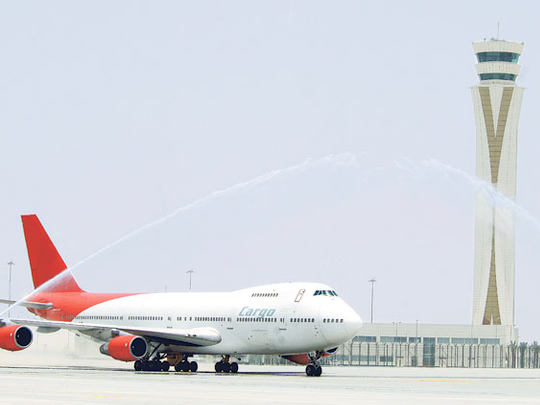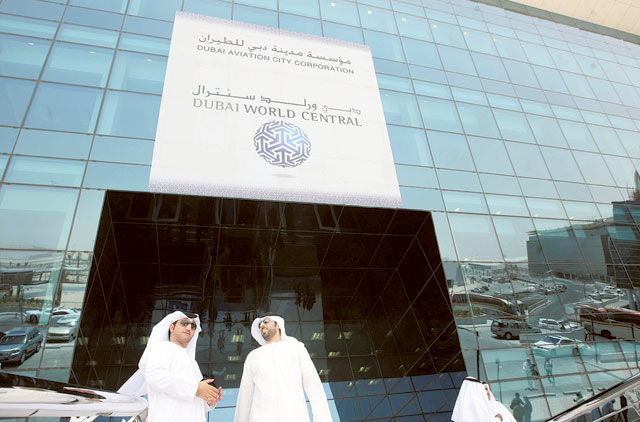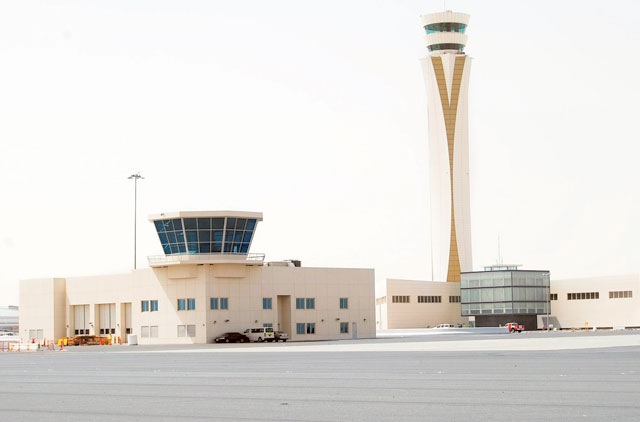
Dubai: Dubai World Central – the Dh120 billion mega aerotropolis spread across a 140 square kilometres patch of landmass in Jebel Ali – will get a solid boost when scheduled passenger flights take off later this year from Al Maktoum International Airport – the world’s biggest greenfield airport development – as the mega project’s centre piece.
Wizz Air, the largest low-fare, low-cost airline in Central and Eastern Europe, will start services to Dubai World Central Al Maktoum International Airport (AMIA) from Budapest (Hungary), Bucharest (Romania), Kiev (Ukraine) and Sofia (Bulgaria) from 28 October 2013. Wizz Air will be joined by Saudi Arabia’s Nas Air in serving the new hub, before others join.
This will be followed by Dubai Airshow 2013, which is scheduled to take place from 17-21 November, which might coincide a possible win of the UAE’s bid to host Expo 2020 in Dubai – that will be a massive shot in the arm for the mega project.
“We are getting ready for the first scheduled commercial flights to take off from Al Maktoum International in October this year which will open a new chapter in the country’s history,” Gary Chapman, President of Emirates Group Services and Dnata, told Gulf News. “The airport officials are negotiating with a number of airlines to start operations from Al Maktoum International. So far, two airlines – Nas Air and Wizz Air have confirmed their operations out of Al Maktoum International.”
Dubai World Central (DWC) is a visionary project for the future of Dubai’s economy that stands on trade, aviation, tourism, logistics and retail. With these developments in essence, the future will not only arrive in Dubai, it will also take off towards a new phase of growth and development.
In sheer size, Dubai World Central (DWC) is almost twice the size of Hong Kong Island and ten times larger than the existing Dubai International Airport – which is spread across 14 square kilometres. As it stands, Dubai International is currently the world’s second biggest hub for international passengers after London Heathrow.
However, the development of DWC was planned as an integrated city to combine the aviation, tourism, logistics and exhibition industries in a world-class airport city, which when completed, will see 160 million people travel through the airport in an environment inhabited by 950,000 residents living in a residential cluster called the Residential City that will host 1,100 buildings and work in the Commercial City that would host 850 towers in a single setting.
“Dubai World Central is ideally located to serve international companies, helping them expand their business and reach their target markets worldwide,” Rashid Bu Qara’a, Chief Operating Officer of Dubai Aviation City Corporation, developer of the DWC, said. “Moreover, the wide selection of services and state-of-the-art facilities available at DWC create new growth opportunities for aviation companies and enable them to enter new markets.”
The development of the DWC was prompted by the strong growth in the emirate’s aviation and tourism sector. Middle East airlines contributed almost a third of the total expansion in international passenger markets with 15.4 per cent growth, said the annual passenger traffic report released by the International Air Transport Association (IATA), the global aviation watchdog.
“This was achieved with a capacity expansion of 12.5 per cent while improving the load factor to 77.4 per cent. The region’s carriers increased the connectivity of their expanding hubs with significant increases in both network [destinations] and frequency,” IATA said in the report, which reflects the fact that at some point in the next few years, the passenger and cargo capacity at Dubai International would have been exhausted, thus requiring the development of a new, larger airport.
“Despite the expansion, the improved load factor indicates that the growth is sustainable and that airlines in the region have been successful in attracting new passengers,” IATA said.
Dubai Government launched the construction of the airport in 2008 – much ahead of the need. Dubai International, which is currently undergoing a fourth phase of expansion with a price tag of Dh28 billion that will raise its passenger capacity to 90 million – up from the existing 70 million, by 2017.
However, as the demand rises, the new airport, AMIA, becomes ready to take off, offering airlines and the government flexibility and more breathing room, analysts say.
“DWC is a natural step in airport infrastructure growth for the UAE. We only have to look at IATA’s monthly traffic reports to see just how furiously the GCC is growing – narrowed down, Dubai Airport alone is rocketing up the passenger traffic charts each and every month, every year and will definitely top 64 million passengers this year,” Saj Ahmad, Chief Analyst of the UK-based StrategicAero Research, told Gulf News.
The DWC is part of Dubai government’s long-term vision to create a large enough aviation hub that will serve the emirate more than 50 years as it seeks to increase the aviation and tourism sector’s contribution to Dubai’s economy.
“Added capacity can take years to come on stream, and we have already seen DWC scaled back from 6 runways to 5 – so no, the plans for the mega airport are realistic and not ostentatious. It is within keeping of planned growth for the city and the wider UAE,” Ahmad said.
AMIA will have a design-built capacity to handle up to 160 million passengers to be processed by six concourses, two terminals and carried through five parallel runways. To put in perspective, the world’s top five airports handle between 65 and 95 million passengers per annum. Dubai International last year handled 57 million and is poised to cross the 64 million figure this year.
Phase 1 of the AMIA is completed and fully operational. The international airport currently has the capacity to handle 600,000 tonnes per annum and operates 24 hours a day on an A380-compatible, 4.5 km runway. Facilities include 64 aircraft stands (10 of which are Code F), a state-of-the-art ATC (air traffic control) Tower, fire stations, line maintenance services, a fuel farm and a 66,000 square meter, single-level passenger terminal.
With Dubai International’s capacity of 90 million, the two airports will have a combined capacity to handle 250 million passengers annually – a massive traffic for a city of just over 2 million residents.
Dubai has already become the de-facto crossroads for the entire planet. “The whole DWC set up will allow customers to connect via the city and leap to any other city on the planet with just that one stop,” Ahmad says. “This is about services – and arguably, the aggressive growth demonstrated by incumbents like Emirates and flydubai are huge catalysts, notwithstanding the growth in regional GCC traffic as well – and the bottom line is that people simply want to use Dubai before any other city airport.”
DWC is also part of the Dubai Government’s vision to strengthen its non-oil economy and prepare it for the future when oil runs out. The emirate, whose economy has firmly been rooted in trade and retail sectors, has successfully expanded into aviation and tourism — currently the biggest contributor to Dubai’s economy.
“DWC has been architected from the onset as a self-contained economic and social ecosystem,” says a spokesperson. “Ambitious in scale, the holistically conceived master plan is the result of careful consideration and understanding of the correlation between a city’s GDP growth and its investment in transportation/logistics infrastructure.”
Solid fundamentals support DWC’s overall vision, says the company’s website. The Jebel Ali Port is the largest container port located between Rotterdam and Singapore, with 124 weekly services spanning 90 destinations across the globe. There are 6,000 weekly flights by 150 airlines to 210 destinations.
On top of that, Emirates is projected to become the world’s largest airline by 2015. “Dubai Cargo Village and the Dubai International Airport are near capacity with demand steadily on the rise; 160,000 registered companies contribute to fuel $156 billion worth of foreign trade by land, sea and air,” it says.
Echoing this, Ahmad says, “Over the next 20 years DWC will be the backbone of air traffic capacity for Dubai, the UAE and the GCC. Adding capacity will actually ease, not increase congestion. Between the two Dubai airports, you’re looking at capacity around the 210 million passengers mark – and that level will continue to rise. It won’t be stagnant for very long.”
However, with its sheer size and magnitude of operations, one question remains – Will the DWC be sustainable?
With the current airport already running ever closer to its maximum capacity, DWC will at first cater for overspill and for airlines looking for a less congested hub, observers say.
“Over time, as DWC grows and Dubai’s road/rail links to the airport increase and airport landing fees become more competitive, the natural shift for future growth will defect to DWC away from DXB,” Ahmad says. “There is no question in my mind that DWC is literally here for the long haul. You don’t plan an airport like this for the next 10-15 years. This is a 50-year-plus project that will never lack investment.”
Bus services for passengers
With two airports running, a facility to fast-track transit passengers will become vital in the efficiency of travel through Dubai. However, that might not be needed for a few years time. This year, the emirate will need to deploy buses to carry passengers.
Dubai’s Roads and Transport Authority and Dubai World Central (DWC) are finalising plans to start a bus service to the airport.
“We expect a strong network of bus services to support the airport operations,” Gary Chapman, President of Emirates Group Services and Dnata, said.
His organisation, dnata is in charge of the ground operations at the airport. “We are getting ready for the operation. Our people are already on board as the airport currently runs cargo operation.”
Al Maktoum International Airport (AMIA), the centrepiece of the DWC, was inaugurated by His Highness Shaikh Mohammad Bin Rashid Al Maktoum, Vice-President and Prime Minister of the UAE and Ruler of Dubai, in 2010.
He said all preparations are in place to kick-start passenger services.
A fast-track rail network to shuttle transit passengers is expected to be built closer to 2020, when Emirates starts to shift its flights to AMIA that will require fast transfer of passengers between the two hub airports.












